文章目录
1.实现目标
本文在UE5 中读取本地的dicom 文件,解析像素值、窗宽窗位等信息,生成2D纹理,在UE场景中实现简单的
2D医学影像可视化
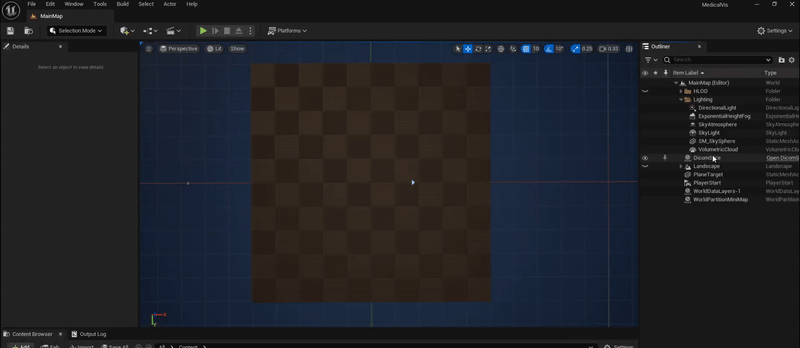
2.实现过程
包括数据准备,dicom三方库在UE工程中的集成,dicom文件中像素值,窗宽窗位Tag的解析,纹理的生成,显示处理的材质等,以实现最终在UE场景中显示2D医学影像
2.1 数据准备
(1)基于开源的dicom数据,链接在文章第三部分参考资料中
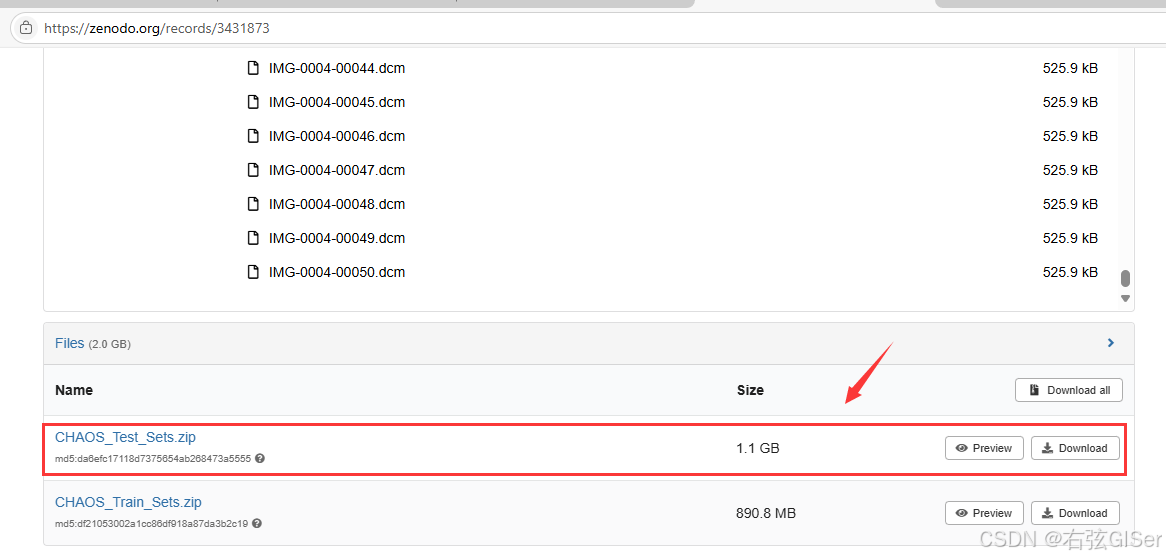
(2)在Radiant Viewer中选择一张dicom查看,如下图所示,也是此次本地使用的单张单帧dicom测试数据
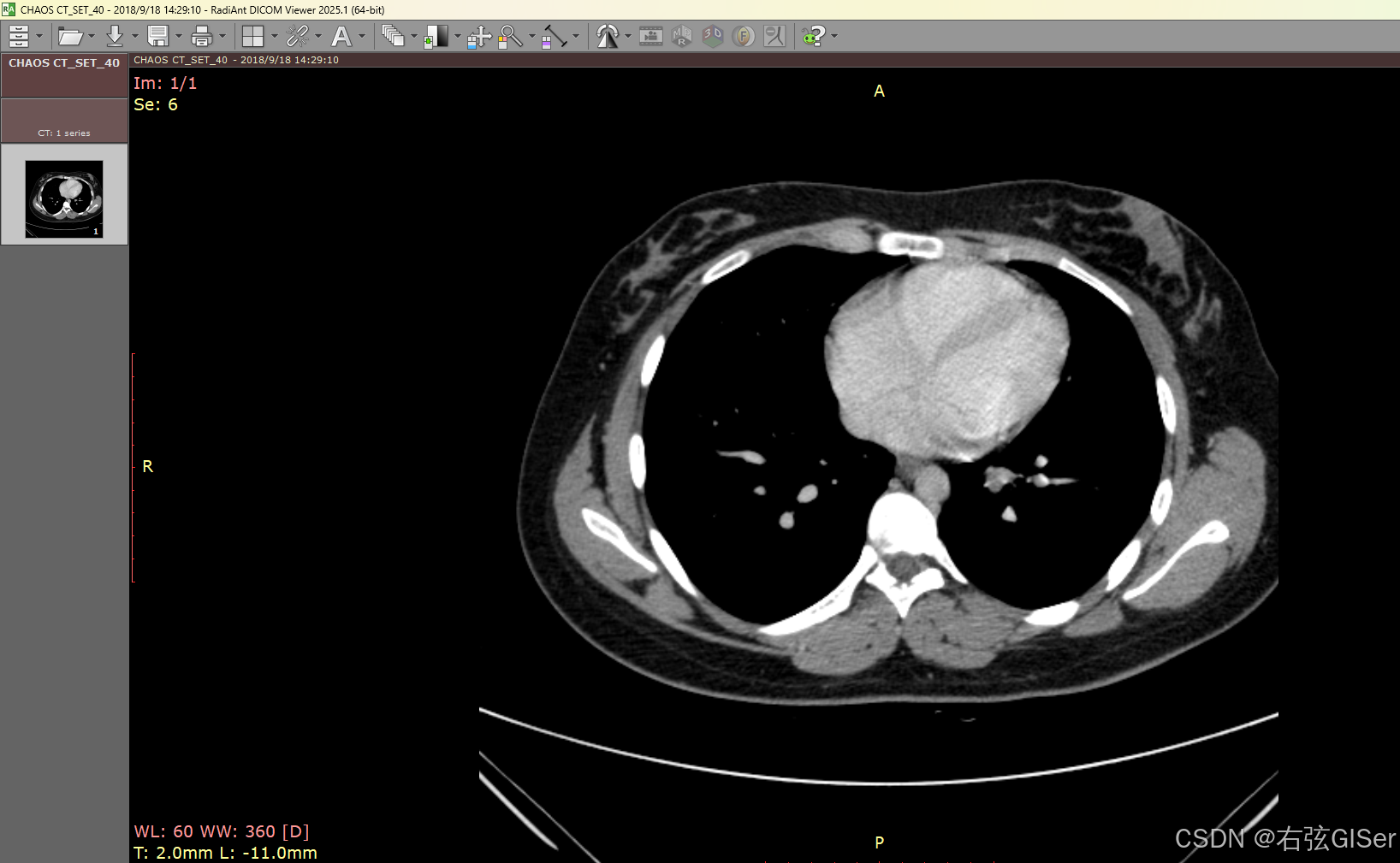
2.2 创建项目
创建引擎自带的 C++项目,这里不再赘述
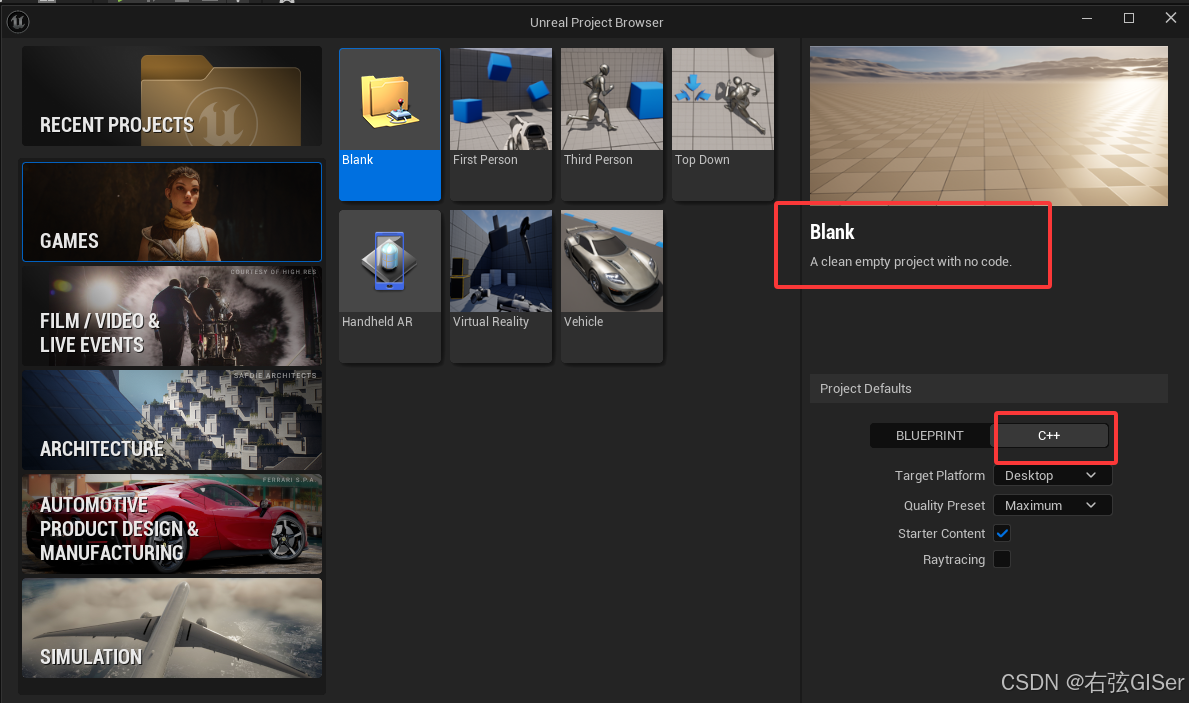
2.3 dcmtk库集成
由于gdcm库在集成过程中,有较多的冲突需要解决,为了集成方便起见,所以本文这里直接对
dcmtk库进行集成。(直接使用github上编译好的库,也可以下载源码自己本地编译)
(1)以插件的形式集成三方库,这也是目前UE官方所推荐的方式。这里使用的是空白的插件模板。
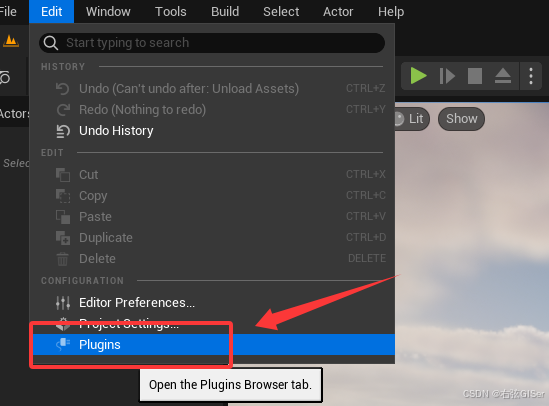
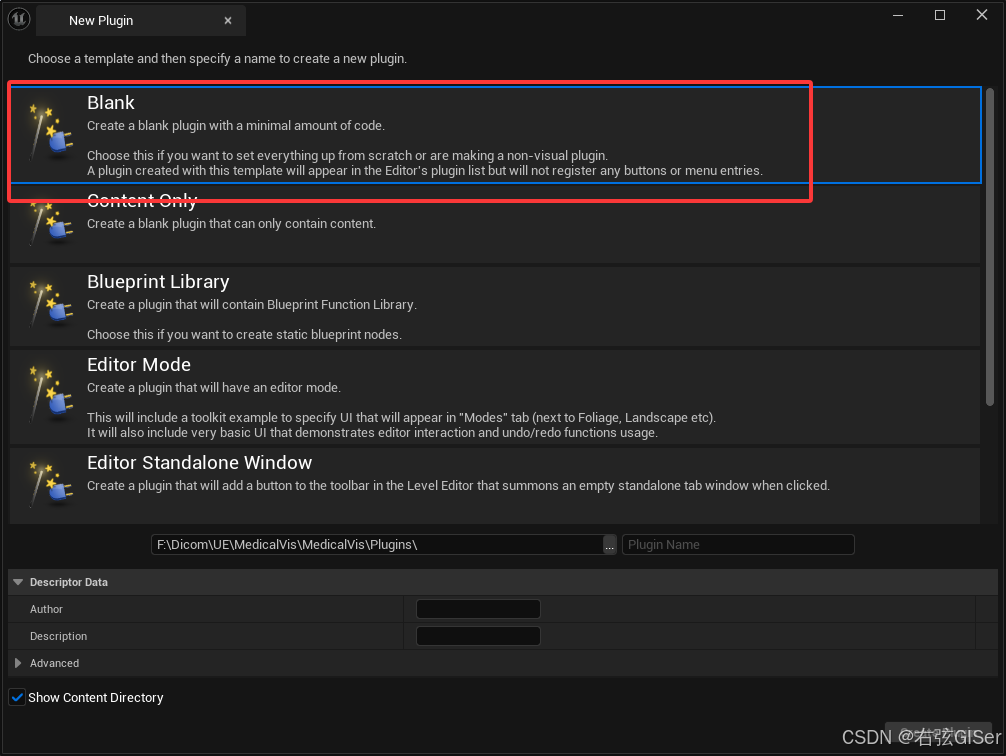
(2)插件目录 ,其中后续使用的usf等shader相关文件,都放在Shaders文件夹中。
第三方库dcmtk 的相关内容,都放在插件source 中的ThirdParty文件夹下
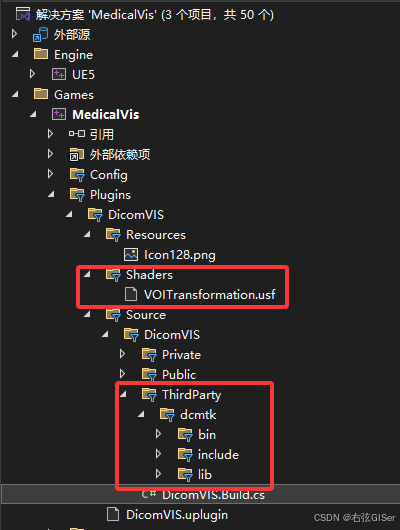
(3)下载dcmtk 库,直接从github 上下载dcmtk的release 版本(https://github.com/DCMTK/dcmtk/releases)
其中包含了需要的头文件,以及静态库lib和动态库dll等。(也可以下载源码,自己本地编译)
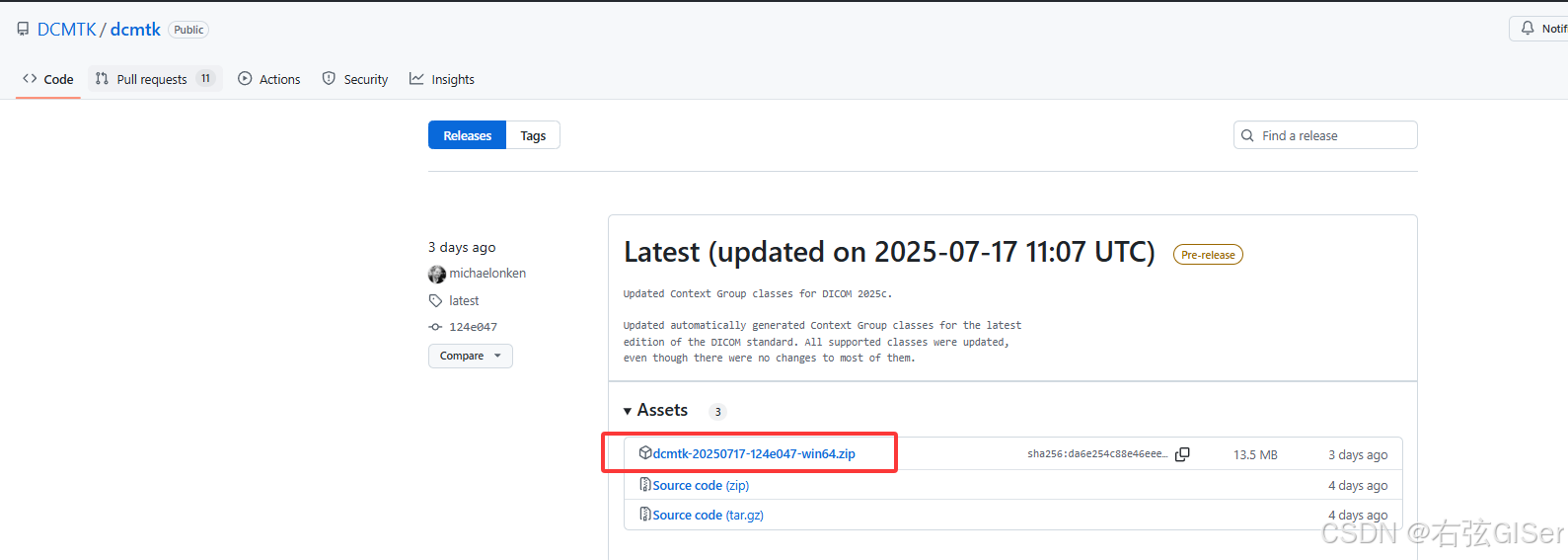
(4)在插件的Build.cs中配置对三方库的引用,防止找不到头文件或者库等报错

插件的build.cs完整代码如下所示:
cpp
// Copyright Epic Games, Inc. All Rights Reserved.
using System.IO;
using UnrealBuildTool;
public class DicomVIS : ModuleRules
{
public DicomVIS(ReadOnlyTargetRules Target) : base(Target)
{
PCHUsage = ModuleRules.PCHUsageMode.UseExplicitOrSharedPCHs;
PublicIncludePaths.AddRange(
new string[] {
// ... add public include paths required here ...
}
);
PrivateIncludePaths.AddRange(
new string[] {
// ... add other private include paths required here ...
}
);
PublicDependencyModuleNames.AddRange(
new string[]
{
"Core",
"ImageWrapper"
// ... add other public dependencies that you statically link with here ...
}
);
PrivateDependencyModuleNames.AddRange(
new string[]
{
"CoreUObject",
"Engine",
"Slate",
"SlateCore",
// for custom shaders
"RenderCore"
}
);
DynamicallyLoadedModuleNames.AddRange(
new string[]
{
// ... add any modules that your module loads dynamically here ...
}
);
PublicIncludePaths.AddRange(
new string[] {
Path.Combine(ModuleDirectory, "ThirdParty/dcmtk/include")
}
);
string libPath = Path.Combine(ModuleDirectory, "ThirdParty/dcmtk/lib");
string[] allLibs = Directory.Exists(libPath) ? Directory.GetFiles(libPath, "*.lib") : new string[0];
PublicAdditionalLibraries.AddRange(allLibs);
string dllPath = Path.Combine(ModuleDirectory, "ThirdParty/dcmtk/bin");
string[] allDlls = Directory.Exists(dllPath) ? Directory.GetFiles(dllPath, "*.dll") : new string[0];
foreach (string currentDll in allDlls)
{
string dllName = Path.GetFileName(currentDll);
PublicDelayLoadDLLs.Add(dllName);
// copy dll to project directory binaries dir
string targetDllPath = Path.Combine(PluginDirectory, "../../Binaries/Win64/" + dllName);
RuntimeDependencies.Add(targetDllPath, currentDll);
}
}
}(5)集成过程中可能会遇到的问题
① 引入dcmtk库相关头文件时,verify、check等宏冲突
报错如下所示:

解决方法:
cpp
// DCMTK uses their own verify and check macros.
// Also, they include some effed up windows headers which for example include min and max macros for that
// extra bit of _screw you_
#pragma push_macro("verify")
#pragma push_macro("check")
#undef verify
#undef check
#include "dcmtk/dcmdata/dcdatset.h"
#include "dcmtk/dcmdata/dcdeftag.h"
#include "dcmtk/dcmdata/dcfilefo.h"
#include "dcmtk/dcmdata/dcpixel.h"
#include "dcmtk/dcmimgle/dcmimage.h"
#pragma pop_macro("verify")
#pragma pop_macro("check")②"UpdateResourceW": 不是 "UTexture2D" 的成员,原因是dcmtk中引用了windows的相关头文件WinBase.h中已经定义了相关的宏

报错如下所示:

解决方法:前置声明
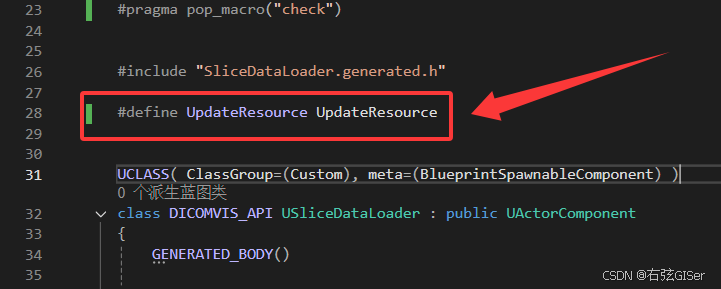
2.4 流程&原理
使用dcmtk库解析dicom数据中的像素数据,以及窗宽窗位等数据,再按照
dicom标准的显示处理流程处理即可。
(完整源码在本文2.6部分,此部分仅作为原理说明)
(1)使用dcmtk库解析dicom数据中的像素值,和窗宽窗位tag信息,这三个信息是显示的必要参数
直接根据相关tag解析即可,本文这里使用的无符号的16bit测试数据,其他类型暂无考虑(原理相同,参数修改下即可)

(2)窗宽窗位特殊处理
在上一篇文章中介绍了常规的dicom数据显示流程,即先根据slope 和intercept 进行modality变换,在根据windowCenter 和windowWidth 等进行VOI变换。但本文这里是直接将没有经过modality变换的原始像素值直接生成了2D纹理,后续的显示处理都在shader中处理,所以这里直接对窗宽窗位应用modality反变换,这样就在shader中节约了一次modality变换的消耗

(3)创建纹理并更新像素数据
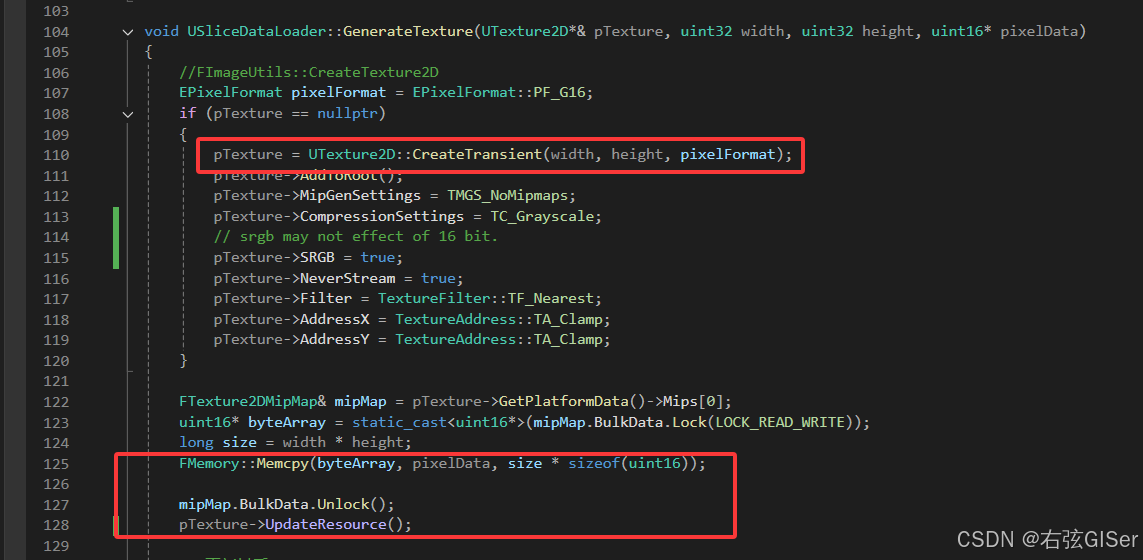
(4)最终显示:使用材质处理完成后,在Plane 等StaticMesh的载体上显示即可
2.5 材质
关于dicom显示过程中的一些特殊处理,如VOI变换等,可以使用Material Function等方式,为了后续使用的方便,本文这里使用
usf的shader方式实现
(1)在插件中添加对shader文件夹的映射,以便可以在材质编辑器中使用。
cpp
// find shaders
FString shaderDir = FPaths::Combine(FPaths::ProjectPluginsDir(), "DicomVIS/Shaders/");
AddShaderSourceDirectoryMapping("/DicomVIS", shaderDir);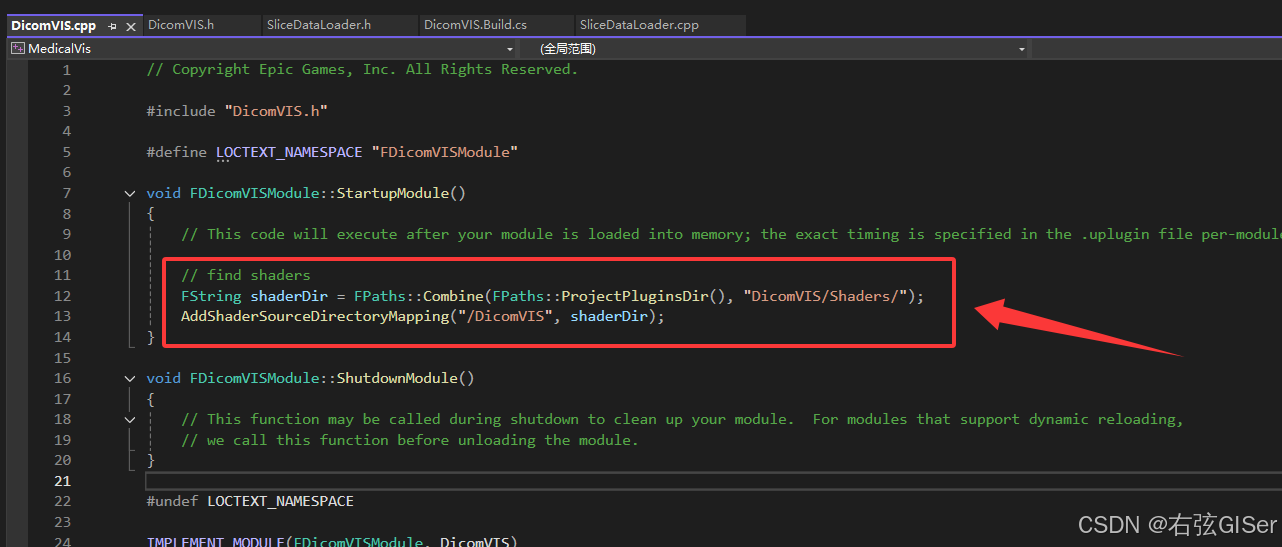
(2)在UE编辑器中创建材质,并设置为Unlit无光照模式,以避免UE中光照对dicom医学影像造成的颜色偏差等
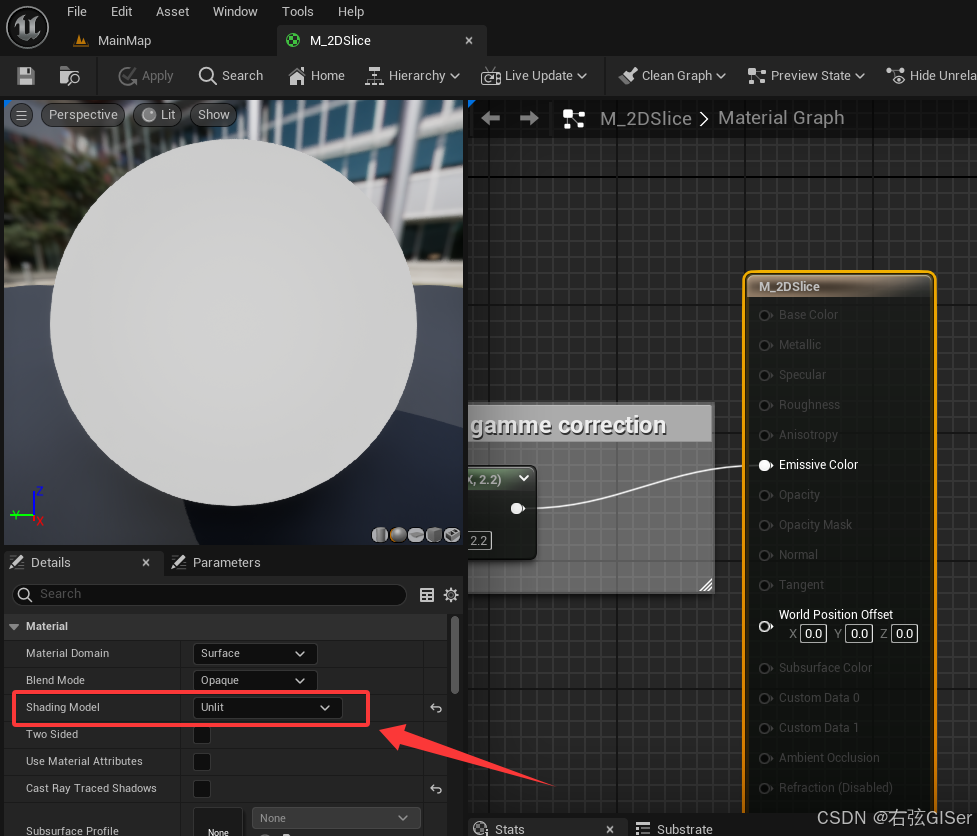
(3)该材质的主要节点如下所示。其中SliceTex参数为dicom像素值生成的2D纹理,WindowWidth和WindowCenter为窗宽窗位信息,DataRange为数据的范围,如本文使用的G16 格式纹理,则该值为65535;若材质为G8格式的纹理,则该值为255
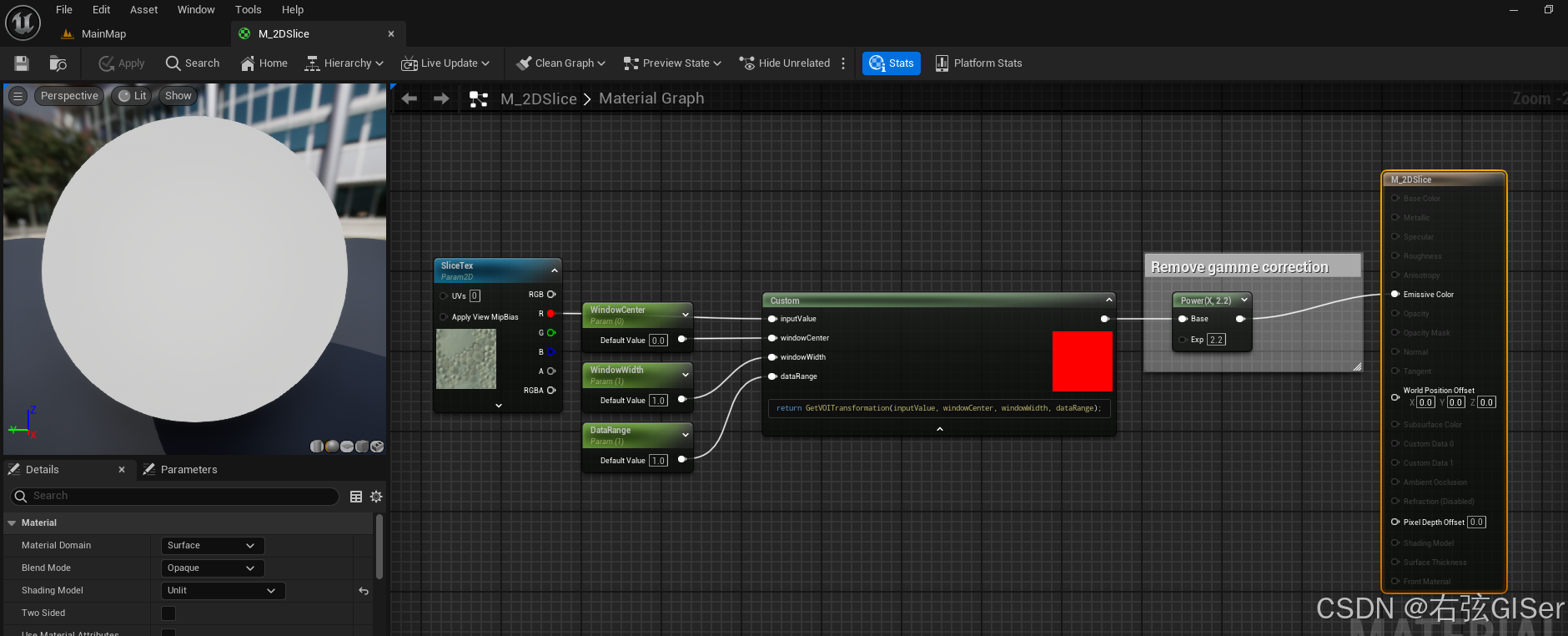
(4)新建usf,用于dicom显示过程中的VOI变换
cpp
float GetVOITransformation(float inputValue, float windowCenter, float windowWidth, float range)
{
return saturate((inputValue - windowCenter + 0.5 / range) / (windowWidth - 1.0 / range) + 0.5);
}
(5)新建自定义材质节点,并设置输入和输出的参数类型
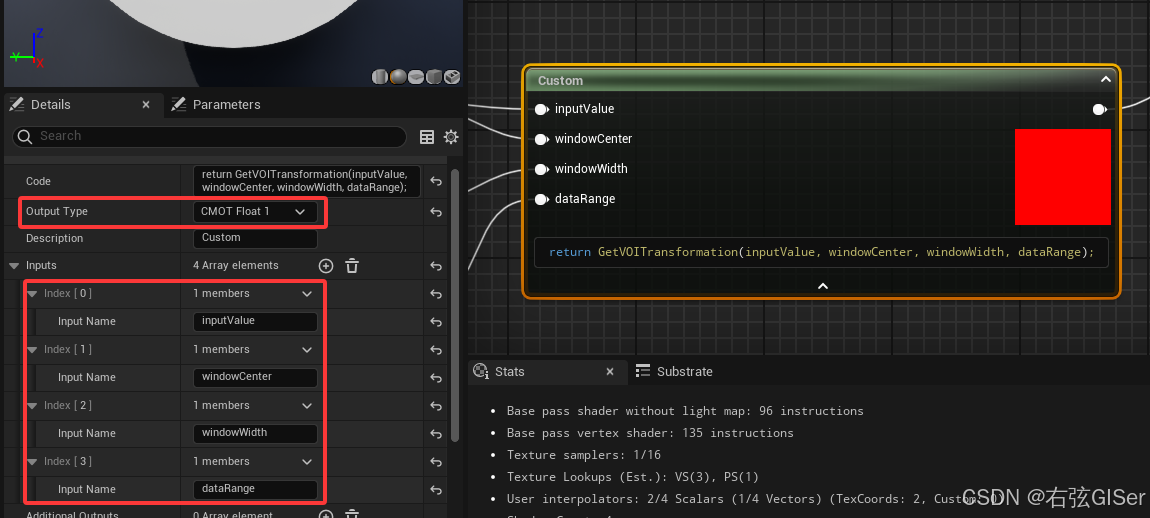
(6)设置自定义材质节点的Code和包含头文件路径,以便可以在材质中使用usf中的函数
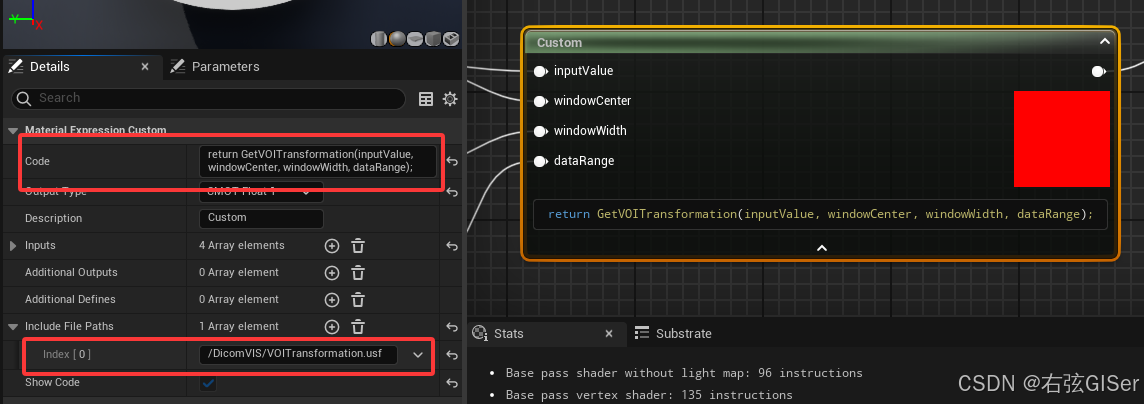
2.6 应用实现
包括具体的实现步骤,可以在UE中Editor环境下加载Dicom数据,生成2D纹理和最终显示。
本文这里只演示了16位无符号的dicom数据处理流程,其他类型的类似,需要修改生成材质的格式等参数即可
(1)dicom解析 ,以及生成纹理的相关功能,本文这里基于ActorCompoent实现,具体C++代码如下所示:
SliceDataLoader.h:
cpp
// Fill out your copyright notice in the Description page of Project Settings.
#pragma once
#include "CoreMinimal.h"
#include "Components/ActorComponent.h"
#include "Engine/StaticMeshActor.h"
// DCMTK uses their own verify and check macros.
// Also, they include some effed up windows headers which for example include min and max macros for that
// extra bit of _screw you_
#pragma push_macro("verify")
#pragma push_macro("check")
#undef verify
#undef check
#include "dcmtk/dcmdata/dcdatset.h"
#include "dcmtk/dcmdata/dcdeftag.h"
#include "dcmtk/dcmdata/dcfilefo.h"
#include "dcmtk/dcmdata/dcpixel.h"
#include "dcmtk/dcmimgle/dcmimage.h"
#pragma pop_macro("verify")
#pragma pop_macro("check")
#include "SliceDataLoader.generated.h"
#define UpdateResource UpdateResource
UCLASS( ClassGroup=(Custom), meta=(BlueprintSpawnableComponent) )
class DICOMVIS_API USliceDataLoader : public UActorComponent
{
GENERATED_BODY()
public:
// Sets default values for this component's properties
USliceDataLoader();
// The dicom data path, that is the relative path of ue game project directory.
UPROPERTY(EditAnywhere, BlueprintReadWrite, Category = "Dicom")
FString TargetFilePath = "Data/test.dcm";
// Plane static mesh component
UPROPERTY(EditAnywhere, BlueprintReadWrite, Category = "Dicom")
AStaticMeshActor* pPlaneMesh = nullptr;
// 2d slice material
UPROPERTY(EditAnywhere, BlueprintReadWrite, Category = "Dicom")
UMaterial* pMaterial = nullptr;
// The dicom pixel data texture2D
UPROPERTY(EditAnywhere, BlueprintReadWrite, Category = "Dicom")
UTexture2D* pTexture2D;
// Window Center of dicom
UPROPERTY(EditAnywhere, BlueprintReadWrite, Category = "Dicom")
float WindowCenter;
// Window width of dicom
UPROPERTY(EditAnywhere, BlueprintReadWrite, Category = "Dicom")
float WindowWidth;
// The min value of dicom data
UPROPERTY(EditAnywhere, BlueprintReadOnly, Category = "Dicom")
float Min = 0;
// The range of dicom data, range = max - min
UPROPERTY(EditAnywhere, BlueprintReadOnly, Category = "Dicom")
float Range = 1;
// slope value of dicom
UPROPERTY(EditAnywhere, BlueprintReadOnly, Category = "Dicom")
float Slope = 0;
// intercept value of dicom
UPROPERTY(EditAnywhere, BlueprintReadOnly, Category = "Dicom")
float Intercept = 0;
// dicom image width
UPROPERTY(EditAnywhere, BlueprintReadOnly, Category = "Dicom")
int Width = 0;
// dicom image height
UPROPERTY(EditAnywhere, BlueprintReadOnly, Category = "Dicom")
int Height = 0;
// dicom image depth
UPROPERTY(EditAnywhere, BlueprintReadOnly, Category = "Dicom")
int Depth = 0;
// Load dicom data from load file path, parse pixel data to texture2D
UFUNCTION(CallInEditor, BlueprintCallable, Category = "Dicom")
void LoadDicom();
protected:
// Called when the game starts
virtual void BeginPlay() override;
// use dicom pixel data to generate texture (uint16)
void GenerateTexture(UTexture2D*& pTexture, uint32 width, uint32 height, uint16* pixelData);
public:
// Called every frame
virtual void TickComponent(float DeltaTime, ELevelTick TickType, FActorComponentTickFunction* ThisTickFunction) override;
};SliceDataLoader.cpp:
cpp
// Fill out your copyright notice in the Description page of Project Settings.
#include "SliceDataLoader.h"
#include <Kismet/KismetSystemLibrary.h>
#include <ImageUtils.h>
// Sets default values for this component's properties
USliceDataLoader::USliceDataLoader()
{
// Set this component to be initialized when the game starts, and to be ticked every frame. You can turn these features
// off to improve performance if you don't need them.
PrimaryComponentTick.bCanEverTick = true;
// ...
}
void USliceDataLoader::LoadDicom()
{
FString dicomFilePath = UKismetSystemLibrary::GetProjectDirectory() + TargetFilePath;
if (!FPaths::FileExists(dicomFilePath))
{
UE_LOG(LogTemp, Error, TEXT("dicom file is not exist, please check!"));
return;
}
// ToDo: use other thread to process
AsyncTask(ENamedThreads::GameThread, [=, this]() {
DcmFileFormat fileFormat;
if (fileFormat.loadFile(TCHAR_TO_ANSI(*dicomFilePath)).good())
{
UE_LOG(LogTemp, Log, TEXT("dicom file loaded successfully!"));
DcmDataset* dataset = fileFormat.getDataset();
dataset->chooseRepresentation(EXS_LittleEndianImplicit, nullptr);
Float64 windowCenter;
dataset->findAndGetFloat64(DCM_WindowCenter, windowCenter);
this->WindowCenter = windowCenter;
Float64 windowWidth;
dataset->findAndGetFloat64(DCM_WindowWidth, windowWidth);
this->WindowWidth = windowWidth;
Float64 slope;
dataset->findAndGetFloat64(DCM_RescaleSlope, slope);
this->Slope = slope;
Float64 intercept;
dataset->findAndGetFloat64(DCM_RescaleIntercept, intercept);
this->Intercept = intercept;
Uint16 bitsAllocated;
dataset->findAndGetUint16(DCM_BitsAllocated, bitsAllocated);
this->Depth = bitsAllocated;
Uint8 pixelRepresentation = 0;
dataset->findAndGetUint8(DCM_PixelRepresentation, pixelRepresentation);
bool isSigned = pixelRepresentation == 1;
DicomImage* dcmImage = new DicomImage(TCHAR_TO_ANSI(*dicomFilePath));
if (dcmImage->getStatus() != EIS_Normal)
{
UE_LOG(LogTemp, Error, TEXT("dicom file image loaded failed!"));
return;
}
const int width = dcmImage->getWidth();
this->Width = width;
const int height = dcmImage->getHeight();
this->Height = height;
DcmElement* pixelDataElement;
dataset->findAndGetElement(DCM_PixelData, pixelDataElement);
// Tips:current just support r16 format
if (bitsAllocated == 16)
{
TArray<int> resArray;
if (!isSigned)
{
uint16* pixelData = nullptr;
pixelDataElement->getUint16Array(pixelData);
this->GenerateTexture(this->pTexture2D, this->Width, this->Height, pixelData);
}
}
}
});
}
// Called when the game starts
void USliceDataLoader::BeginPlay()
{
Super::BeginPlay();
// ...
}
void USliceDataLoader::GenerateTexture(UTexture2D*& pTexture, uint32 width, uint32 height, uint16* pixelData)
{
//FImageUtils::CreateTexture2D
EPixelFormat pixelFormat = EPixelFormat::PF_G16;
if (pTexture == nullptr)
{
pTexture = UTexture2D::CreateTransient(width, height, pixelFormat);
pTexture->AddToRoot();
pTexture->MipGenSettings = TMGS_NoMipmaps;
pTexture->CompressionSettings = TC_Grayscale;
// srgb may not effect of 16 bit.
pTexture->SRGB = true;
pTexture->NeverStream = true;
pTexture->Filter = TextureFilter::TF_Nearest;
pTexture->AddressX = TextureAddress::TA_Clamp;
pTexture->AddressY = TextureAddress::TA_Clamp;
}
FTexture2DMipMap& mipMap = pTexture->GetPlatformData()->Mips[0];
uint16* byteArray = static_cast<uint16*>(mipMap.BulkData.Lock(LOCK_READ_WRITE));
long size = width * height;
FMemory::Memcpy(byteArray, pixelData, size * sizeof(uint16));
mipMap.BulkData.Unlock();
pTexture->UpdateResource();
// 更新材质
if (pMaterial)
{
UMaterialInstanceDynamic* pMaterialInsDy = UMaterialInstanceDynamic::Create(pMaterial, this);
pMaterialInsDy->SetTextureParameterValue(FName("SliceTex"), pTexture);
// inverset tranform window center and width by slope and intercept;
FFloat16 transWL = (this->WindowCenter - this->Intercept) / this->Slope * 1 / 65535.0;
FFloat16 transWW = (this->WindowWidth) / this->Slope * 1 / 65535.0;
pMaterialInsDy->SetScalarParameterValue(FName("WindowCenter"), transWL);
pMaterialInsDy->SetScalarParameterValue(FName("WindowWidth"), transWW);
pMaterialInsDy->SetScalarParameterValue(FName("DataRange"), 65535.0);
auto pStaticMeshComponent = pPlaneMesh->GetStaticMeshComponent();
pStaticMeshComponent->SetMaterial(0, pMaterialInsDy);
}
}
// Called every frame
void USliceDataLoader::TickComponent(float DeltaTime, ELevelTick TickType, FActorComponentTickFunction* ThisTickFunction)
{
Super::TickComponent(DeltaTime, TickType, ThisTickFunction);
}(2)在场景中添加Plane,用于影像在UE中显示的载体

(3)在UE场景中添加任意的Actor,并添加上文创建的SliceDataLoader组件
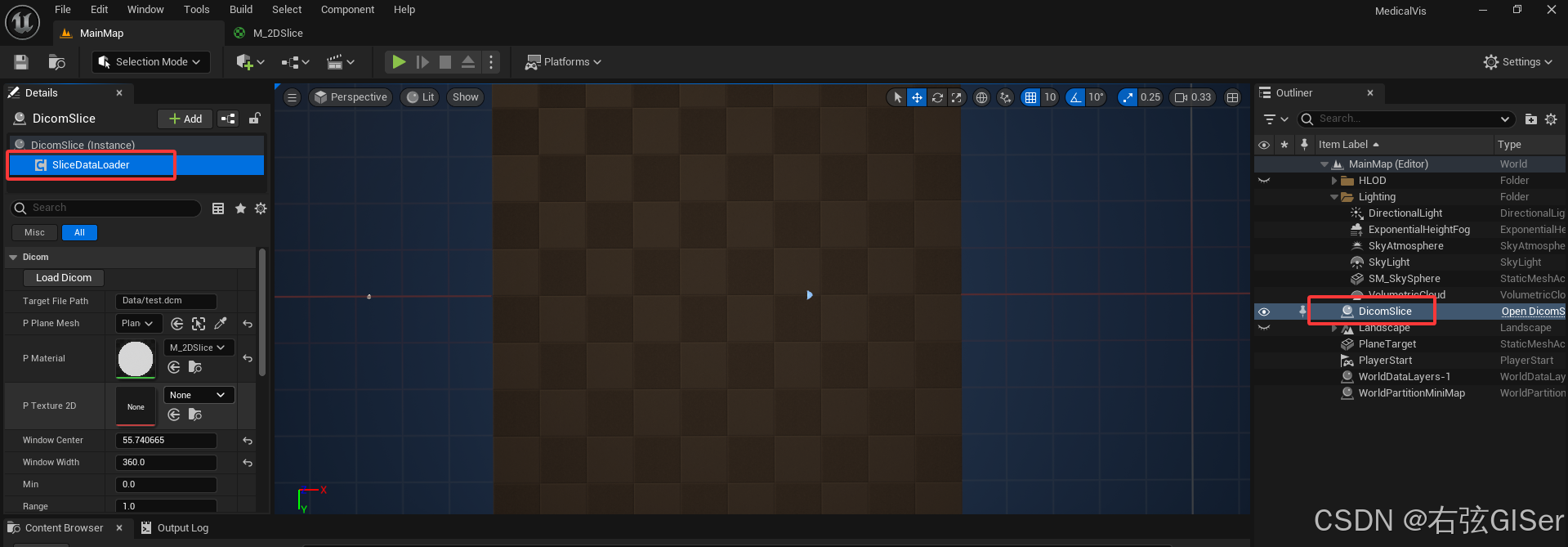
(4)在该组件的细节面板中,选择测试用的dicom文件的相对路径,以及需要应用的材质(上文创建的用于dicom显示处理的材质)等参数
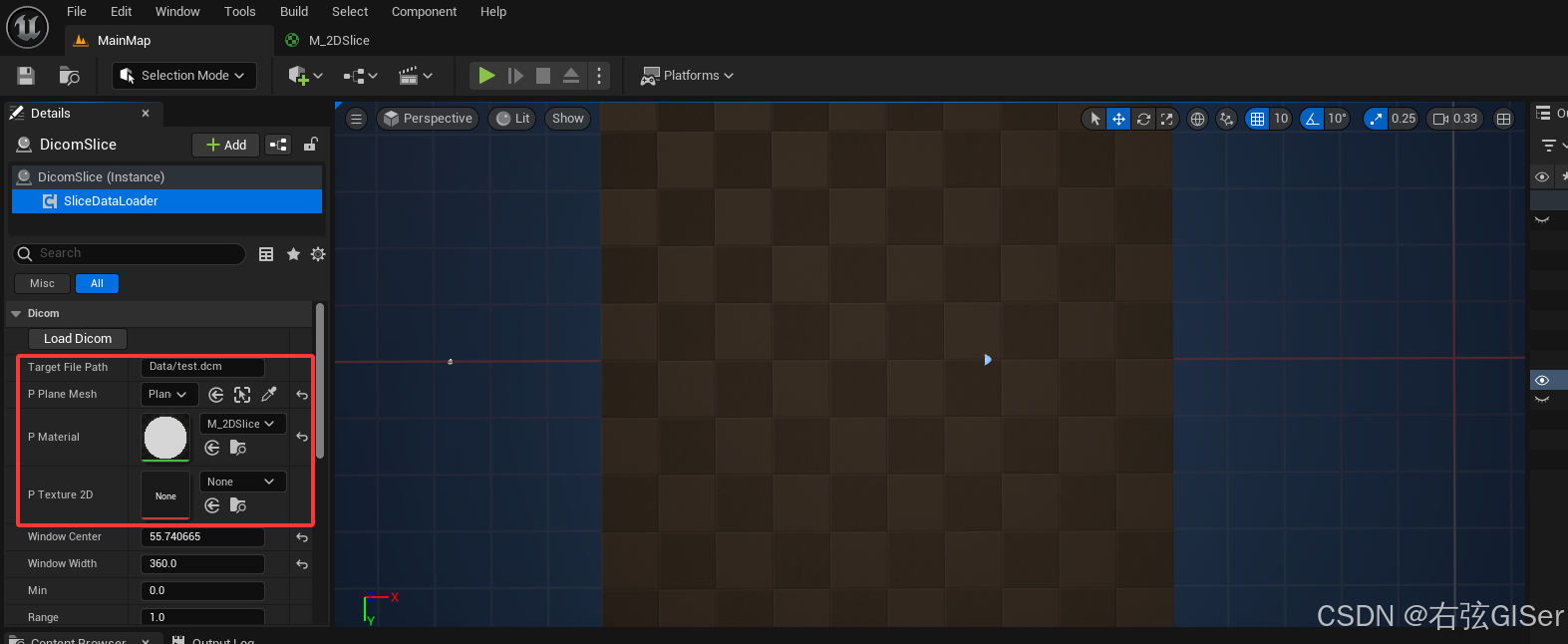
(5)Editor下点击Load Dicom按钮,即可实现对本地Dicom文件的加载解析,2D纹理的生成,以及最终在UE场景中显示正确的Dicom影像
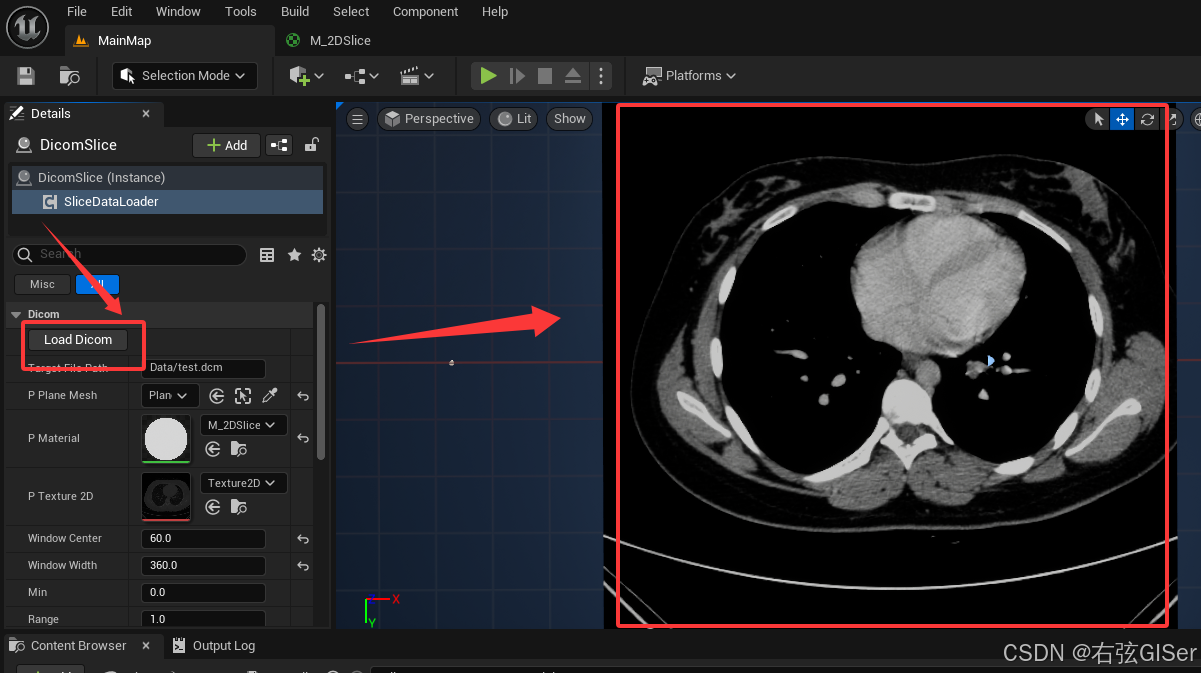
3.参考资料
- 【UE4】使用动态库(DLL)提示找不到dll该怎么解决呢:传送门
- 医学图像数据集集锦(附下载):传送门
- Download Train and Test Data:传送门
- Volume Rendering (Raymarching) Plugin for Unreal Engine:传送门
- DCMTK:传送门
- GDCM:传送门
- UTexture::UpdateResource() overwrote by winbase.h #define:传送门
- UE4 #include <windows.h>之后UpdateResource报错:传送门
- UE4custom node引用自定义.ush .usf文件:传送门
- UE4 Gamma校正、sRGB、Linear:传送门